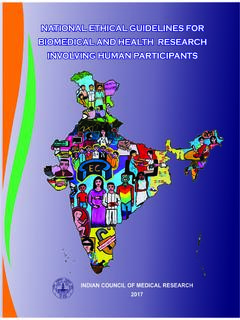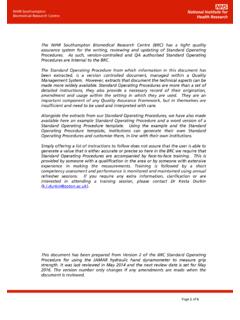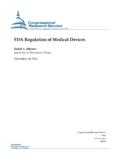Transcription of The Clinical Use of Blood
1 TheClinicalUseofBloodHandbookWorld Health OrganizationBlood Transfusion SafetyGENEVA1 IntroductionThe Clinical Use of Blood forms part of a series of learning materialsdeveloped by WHO/BTS in support of its global strategy for Blood focuses on the Clinical aspects of Blood transfusion and aims to showhow unnecessary transfusions can be reduced at all levels of the healthcare system in any country, without compromising standards of qualityand contains two components: A module of learning material designed for use in educationand training programmes or for independent study by individualclinicians and Blood transfusion specialists A pocket handbook for use in Clinical moduleThe module is designed for prescribers of Blood at all levels of the healthsystem, particularly clinicians and senior paramedical staff at first referrallevel (district hospitals) in developing provides a comprehensive guide to the use of Blood and Blood productsand, in particular, ways of minimizing unnecessary handbookThe pocket handbook summarizes key information from the module toprovide a quick reference when an urgent decision on transfusion is important to follow national guidelines on Clinical Blood use if theydiffer in any way from the guidance contained in the module andhandbook.
2 You may therefore find it useful to add your own notes onnational guidelines or your own experience in prescribing evidence base for Clinical practiceThe Clinical Use of Blood has been prepared by an international team ofclinical and Blood transfusion specialists and has been extensivelyreviewed by relevant WHO departments and by Critical Readers from arange of Clinical disciplines from all six of the WHO regions. The content2reflects the knowledge and experience of the contributors and , since the evidence for effective Clinical practice is constantlyevolving, you are encouraged to consult up-to-date sources of informationsuch as the Cochrane Library, the National Library of Medicine databaseand the WHO Reproductive Health Cochrane Library. Systematic reviews of the effects of health careinterventions, available on diskette, CD-ROM and via the Internet.
3 There areCochrane Centres in Africa, Asia, Australasia, Europe, North America and SouthAmerica. For information, contact: UK Cochrane Centre, NHS research andDevelopment Programme, Summertown Pavilion, Middle Way, Oxford OX2 7LG,UK. Tel: +44 1865 516300. Fax: +44 1865 516311. Library of Medicine. An online biomedical library, including Medline whichcontains references and abstracts from 4300 biomedical journals and ClinicalTrials which provides information on Clinical research studies. National Library ofMedicine, 8600 Rockville Pike, Bethesda, MD 20894, USA. Reproductive Health Library. An electronic review journal focusing onevidence-based solutions to reproductive health problems in developingcountries. Available on CD-ROM from Reproductive Health and research , WorldHealth Organization, 1211 Geneva 27, Switzerland.
4 Appropriate use ofblood and Blood productsKey points1 The appropriate use of Blood and Blood products means thetransfusion of safe Blood products only to treat a condition leadingto significant morbidity or mortality that cannot be prevented ormanaged effectively by other Transfusion carries the risk of adverse reactions and transfusion-transmissible infections. Plasma can transmit most of the infectionspresent in whole Blood and there are very few indications for Blood donated by family/replacement donors carries a higher riskof transfusion-transmissible infections than Blood donated byvoluntary non-remunerated donors. Paid Blood donors generally havethe highest incidence and prevalence of Blood should not be transfused unless it has been obtained fromappropriately selected donors, has been screened for transfusion-transmissible infections and tested for compatibility between thedonor s red cells and the antibodies in the patient s plasma, inaccordance with national The need for transfusion can often be avoided by.
5 The prevention or early diagnosis and treatment of anaemia andconditions that cause anaemia The correction of anaemia and the replacement of depleted ironstores before planned surgery The use of simple alternatives to transfusion, such as intravenousreplacement fluids Good anaesthetic and surgical appropriate use of blood4 Appropriate and inappropriatetransfusionBlood transfusion can be a life-saving intervention. However, like alltreatments, it may result in acute or delayed complications and carriesthe risk of transfusion-transmissible infections, including HIV, hepatitisviruses, syphilis, malaria and Chagas safety and effectiveness of transfusion depend on two key factors: A supply of Blood and Blood products that are safe, accessibleat reasonable cost and adequate to meet national needs The appropriate Clinical use of Blood and Blood is often unnecessary for the following The need for transfusion can often be avoided or minimized bythe prevention or early diagnosis and treatment of anaemiaand conditions that cause Blood is often unnecessarily given to raise a patient shaemoglobin level before surgery or to allow earlier dischargefrom hospital.
6 These are rarely valid reasons for Transfusions of whole Blood , red cells or plasma are often givenwhen other treatments, such as the infusion of normal salineor other intravenous replacement fluids would be safer, lessexpensive and equally effective for the treatment of acute Patients transfusion requirements can often be minimized bygood anaesthetic and surgical If Blood is given when it is not needed, the patient receives nobenefit and is exposed to unnecessary Blood is an expensive, scarce resource. Unnecessarytransfusions may cause a shortage of Blood products forpatients in real risks of transfusionIn some Clinical situations, transfusion may be the only way to save life orrapidly improve a serious condition. However, before prescribing Blood orblood products for a patient, it is always essential to weigh up the risks oftransfusion against the risks of not appropriate use of blood5 Red cell transfusion1 The transfusion of red cell products carries a risk of serioushaemolytic transfusion Blood products can transmit infectious agents, including HIV,hepatitis B, hepatitis C, syphilis.
7 Malaria and Chagas diseaseto the Any Blood product can become contaminated with bacteria andvery dangerous if it is manufactured or stored transfusion1 Plasma can transmit most of the infections present in Plasma can also cause transfusion There are few clear Clinical indications for plasma risks very often outweigh any possible benefit to safetyThe quality and safety of all Blood and Blood products must be assuredthroughout the process from the selection of Blood donors through totheir administration to the patient. This requires:1 The establishment of a well-organized Blood transfusion servicewith quality systems in all The collection of Blood only from voluntary non-remunerateddonors from low-risk populations and rigorous procedures fordonor The screening of all donated Blood for transfusion-transmissibleinfections.
8 HIV, hepatitis viruses, syphilis and, whereappropriate, other infectious agents, such as Chagas diseaseand Good laboratory practice in all aspects of Blood grouping,compatibility testing, component preparation and the storageand transportation of Blood and Blood A reduction in unnecessary transfusions through theappropriate Clinical use of Blood and Blood products, and theuse of simple alternatives to transfusion, wherever appropriate use of blood6 Other than in the most exceptional life-threatening situations, Blood shouldnot be issued for transfusion unless it has been obtained from appropriatelyselected donors and has been screened for transfusion-transmissibleinfections, in accordance with national the local system for the collection, screening and processing ofblood, clinicians must be familiar with it and understand any limitationsthat it may impose on the safety or availability of of Clinical transfusion practiceTransfusion is only one part of the patient s management.
9 The need fortransfusion can often be minimized by the following The prevention or early diagnosis and treatment of anaemiaand the conditions that cause anaemia. The patient shaemoglobin level can often be raised by iron and vitaminsupplementation without the need for transfusion. Red celltransfusion is needed only if the effects of chronic anaemia aresevere enough to require rapid raising of the haemoglobin The correction of anaemia and replacement of depleted ironstores before planned The use of intravenous fluid replacement with crystalloids orcolloids in cases of acute Blood Good anaesthetic and surgical management, including: Using the best anaesthetic and surgical techniques tominimize Blood loss during surgery Stopping anticoagulants and anti-platelet drugs beforeplanned surgery, where it is safe to do so Minimizing the Blood taken for laboratory use, particularly inchildren Salvaging and reinfusing surgical Blood losses Using alternative approaches such as desmopressin,aprotinin or appropriate use of blood7 PRINCIPLES OF Clinical TRANSFUSION PRACTICE1 Transfusion is only one part of the patient s Prescribing should be based on national guidelines on the Clinical use ofblood, taking individual patient needs into Blood loss should be minimized to reduce the patient s need The patient with acute Blood loss should receive effective resuscitation(intravenous replacement fluids, oxygen, etc.)
10 While the need fortransfusion is being The patient s haemoglobin value, although important, should not be thesole deciding factor in starting transfusion. This decision should besupported by the need to relieve Clinical signs and symptoms andprevent significant morbidity or The clinician should be aware of the risks of transfusion-transmissibleinfections in the Blood products that are available for the Transfusion should be prescribed only when the benefits to the patientare likely to outweigh the The clinician should record the reason for transfusion A trained person should monitor the transfused patient and respondimmediately if any adverse effects appropriate use of blood8 Notes9 Replacement fluidsKey points1 Replacement fluids are used to replace abnormal losses of Blood ,plasma or other extracellular fluids by increasing the volume of thevascular compartment, principally in: Treatment of patients with established hypovolaemia.













